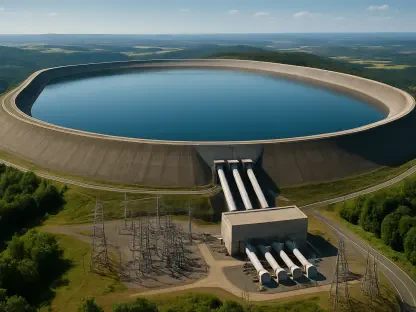President Donald Trump is reportedly preparing to sign a series of executive orders aimed at revitalizing the beleaguered coal industry in the United States. The centerpiece of these efforts is the deployment of emergency authority under the Federal Power Act to compel some coal-fired power plants that are slated for closure to continue operations and provide electricity. This intervention comes at a time when the coal sector has faced numerous headwinds, including stringent regulatory measures and increasing competition from alternative energy sources. Trump’s move is designed to counter these challenges and ensure the continued operation of coal plants vital to grid reliability and national security.
Challenges Facing the Coal Industry
Regulatory Pressures
The coal sector has faced ongoing challenges due to stringent air pollution regulations that have increased operational costs and limited growth. These regulations, primarily aimed at reducing emissions of greenhouse gases and other pollutants, have led to closures and operational cutbacks at numerous coal-fired power plants across the country. The pressure to comply with these environmental standards has been a significant financial burden, driving up costs for companies within the coal industry and making coal-fired power less competitive compared to cleaner alternatives. These regulations are often seen as part of a broader strategy to shift away from fossil fuels and toward renewable energy sources, which can generate electricity without the harmful environmental impact associated with coal.
Moreover, environmental groups have been advocating for stricter regulatory frameworks to curb coal pollution, placing even more pressure on the industry. The call for enhanced regulations is driven by concerns about public health and the global effort to combat climate change. In this context, Trump’s planned executive orders represent a significant policy shift aimed at easing these regulatory constraints to facilitate coal’s revival. While proponents argue that such measures are necessary to support economic growth and ensure energy reliability, critics contend that rolling back environmental protections could have severe long-term consequences for both human health and the environment.
Market Competition
Furthermore, the coal industry has struggled against the rise of alternative energy sources like natural gas, wind, and solar power, which offer more cost-effective options for power generation. The competition is particularly fierce from natural gas due to the fracking revolution, which has significantly lowered the cost of production and made natural gas a more attractive option for utilities and consumers. As a result, many power plants have transitioned from coal to natural gas, further contributing to the decline in coal demand. This shift is not only driven by cost considerations but also by the need to meet environmental regulations, as natural gas burns cleaner than coal and produces fewer emissions.
Renewable energy sources such as wind and solar power have also played a critical role in diminishing coal’s market share. The rapid advancements in technology and reductions in the cost of renewable energy infrastructure have made these alternatives increasingly viable for large-scale power generation. Wind and solar energy offer the additional benefit of being environmentally friendly, aligning with global trends toward sustainable energy practices. These market dynamics have led to a significant reconfiguration of the energy landscape, posing challenges for coal as it struggles to retain its foothold amidst growing competition.
Executive Order Details
Federal Power Act Utilization
Trump’s approach revolves around exploiting a 90-year-old provision of the Federal Power Act, originally intended for wartime usage, to mandate that power plants continue operations beyond planned shutdowns. This provision grants the Energy Secretary the authority to require power plants to remain operational in circumstances where their closure could jeopardize the reliability of the nation’s power grid. By invoking this emergency statute, the administration aims to prevent the premature retirement of coal-fired plants that are essential for meeting the nation’s energy demand, particularly during peak usage periods.
Furthermore, the orders are expected to address specific plants that are not only slated for closure but are strategically important due to their location and capacity. These plants play a crucial role in maintaining grid stability, particularly in regions that rely heavily on coal for electricity. The executive orders will likely mandate the continued operation of these plants, thereby ensuring they can provide the necessary power supply to avert potential shortages, which could be exacerbated by the surging energy demands from expanding industries such as data centers and artificial intelligence.
Emergency Statutes and Environmental Regulations
Other emergency statutes could also enable the federal government to bypass state-level environmental regulations, ensuring that coal plants remain operational. This aspect of the planned executive orders would allow the administration to override state policies that aim to reduce coal use and promote cleaner energy alternatives. By leveraging emergency powers, the federal government could ensure uninterrupted operations of coal-fired plants, countering state-led initiatives that seek to phase out coal in favor of renewable energy sources.
This potential bypass of state regulations is expected to provoke significant debate and legal challenges from environmental groups and state governments advocating for stringent pollution controls. Critics argue that overriding state regulations not only undermines local autonomy but also risks reversing progress made in reducing emissions and promoting clean energy. Supporters, however, maintain that such measures are crucial for national security and economic stability, particularly in regions dependent on coal-fired power for their energy needs. The implementation of these emergency statutes will require a careful balancing act to manage legal constraints and address environmental concerns while maintaining the operational continuity of critical coal plants.
Rationale Behind the Move
Economic Considerations
Trump’s rationale ties the need for these measures to both economic and national security considerations, arguing that overregulation has hurt the U.S. coal industry compared to global competitors. The administration contends that the regulatory environment has placed American coal at a disadvantage, particularly against nations like China, which continue to expand their coal use to fuel economic growth. By easing regulatory pressures, the executive orders aim to level the playing field for American coal, fostering competitiveness and supporting local economies dependent on coal mining and power generation.
Moreover, the coal industry has historically been a significant employer, providing jobs in mining, transportation, and manufacturing sectors. The planned executive orders are framed as essential for preserving these jobs and supporting communities that are economically reliant on coal. The economic rationale extends to the broader energy sector, where maintaining coal-fired power capacity is seen as vital for ensuring grid reliability and preventing energy shortages. By sustaining coal operations, the administration seeks to bolster economic stability and mitigate the ripple effects of plant closures on the labor market.
Energy Demand and National Security
A substantial portion of the demand spike for electricity comes from the rapid expansion of data centers and artificial intelligence infrastructure, requiring significant energy resources. The modern digital economy is increasingly reliant on vast data processing capabilities, which necessitate a stable and robust power supply. Coal-fired plants, with their ability to generate continuous baseline power, are positioned as critical to meeting these growing energy demands. The executive orders aim to safeguard the operational status of coal plants pivotal for supporting the energy-intensive needs of these technological advancements.
In addition to the economic considerations, the administration emphasizes national security as a key driver for the intervention. A reliable energy supply is paramount for national security, ensuring that critical infrastructure and defense systems remain functional without interruptions. The coal industry’s ability to provide consistent power plays a vital role in this context, particularly in scenarios where renewable energy sources may face limitations due to weather conditions or other external factors. By mandating continued coal operations, the executive orders seek to fortify national security by ensuring an uninterrupted power supply to support strategic defense initiatives.
Stakeholder Perspectives
Coal Industry Advocacy
Coal industry advocates, such as America’s Power president Michelle Bloodworth, have commended Trump’s anticipated actions, emphasizing the importance of the coal plants for grid reliability and national security. Bloodworth highlights that some coal-fired units are poised for retirement within the next few years, stressing that their continued operations are crucial for maintaining a stable electricity supply during peak demand periods. The advocacy from coal industry representatives underscores the sector’s reliance on supportive policies to navigate economic and regulatory challenges that have threatened its sustainability.
Moreover, industry proponents argue that the Trump administration’s move is a timely response to the pressures faced by coal companies, contributing to their ability to provide cost-effective energy solutions. The commendation from stakeholders in the coal industry reflects a broader sentiment that sees the planned executive orders as vital for weathering the ongoing storm of competitive market dynamics and regulatory constraints. By ensuring the operational viability of coal-fired plants, the executive orders are seen as a necessary intervention to uphold the energy security and economic well-being associated with coal production.
Industry Needs
Beyond survival, the industry seeks broader measures like accessing new mining areas, reestablishing the National Coal Council, and classifying metallurgical coal as a critical mineral. Access to new mining territories would enable coal companies to explore untapped reserves, potentially increasing their production capacity and contributing to industry growth. The Powder River Basin, with its abundant coal resources, is highlighted as a key area where expanded mining operations could bolster the sector’s resilience and profitability.
Reestablishing the National Coal Council is seen as instrumental for fostering collaborative efforts between industry players and policymakers to address the challenges faced by coal. The council’s role in advising on coal policies and promoting research and development initiatives would be pivotal in ensuring the industry can adapt to evolving market conditions and regulatory landscapes. Additionally, classifying metallurgical coal as a critical mineral would recognize its importance for industrial processes, particularly in steel manufacturing. This classification would facilitate investment and support for metallurgical coal production, reinforcing the industry’s role in providing essential materials for various industrial applications.
Challenges and Criticisms
Legal Uncertainties
Despite industry support, Trump’s earlier attempts to invoke the same sections of the Federal Power Act faced resistance, and the legal validity of prolonged emergency measures remains uncertain. These provisions, while empowering the federal government to mandate continued operations of power plants, were originally intended for short-term use during crises such as wartime scenarios. The extension of these statutes over an extended period, as proposed in the executive orders, could face considerable legal scrutiny and opposition.
Critics argue that the emergency authority granted by the Federal Power Act may not be justified for a prolonged duration, as the initial intent was to address immediate threats rather than sustained economic challenges. Legal experts caution that extending these emergency measures beyond their traditional scope could lead to judicial challenges, with courts potentially questioning the administration’s interpretation of the act’s provisions. The administration will need to navigate this legal landscape carefully, ensuring that its actions can withstand judicial review and align with the statutory framework governing emergency powers.
Economic and Market Dynamics
Economists question the long-term viability of coal compared to natural gas, given that the fracking revolution has made natural gas cheaper and more attractive for power generation. The advancements in hydraulic fracturing have revolutionized the energy market, leading to a significant drop in natural gas prices and increasing its competitiveness against coal. This shift has resulted in many utilities opting for natural gas as a primary source of power generation, benefiting from its cost-efficiency and relatively cleaner burn compared to coal.
Furthermore, the market dynamics evolving around renewable energy sources pose additional challenges for coal. Wind and solar power have seen dramatic reductions in costs due to technological advances and economies of scale, making them increasingly viable alternatives for large-scale power production. These renewable energy sources not only offer cost benefits but also align with global efforts to reduce carbon emissions and combat climate change. The coal industry faces an uphill battle in regaining market share amidst these evolving economic and market dynamics, requiring strategic measures to enhance its competitiveness and sustainability.
Environmental and Regulatory Concerns
Environmental Impact
Environmental groups highlight the adverse climatic and health impacts of coal, considering it a significant source of greenhouse gas emissions. The combustion of coal releases significant amounts of carbon dioxide, sulfur dioxide, and particulate matter, contributing to air pollution and climate change. These emissions have been linked to various health issues, including respiratory illnesses, cardiovascular diseases, and premature deaths. Environmental advocates argue that sustaining coal operations would exacerbate these health risks and hinder efforts to achieve carbon reduction targets set by international climate agreements.
Moreover, the environmental impact of coal mining, including land degradation, water contamination, and habitat destruction, adds to the opposition against continued coal use. Critics emphasize the need for a transition toward cleaner energy sources that can provide sustainable development without compromising environmental integrity. The planned executive orders aimed at relaxing regulatory constraints on coal are met with strong resistance from environmental groups advocating for stricter pollution controls and investment in renewable energy infrastructure.
Grid Readiness
Questions persist about the readiness of the power grid to handle the shift away from fossil fuels, with NERC warning about the risks of poorly managed transitions. The North American Electric Reliability Corporation (NERC) has repeatedly emphasized the importance of maintaining grid stability during energy transitions, cautioning against abrupt shifts that could compromise reliability. The integration of renewable energy sources poses certain challenges, including variability in power generation based on weather conditions, requiring robust grid management strategies to accommodate these fluctuations.
NERC’s warnings underscore the need for a balanced approach that ensures grid readiness while moving toward cleaner energy options. The planned executive orders, by mandating continued coal operations, aim to address these grid reliability concerns by maintaining a steady baseline power supply inherent to coal-fired plants. However, this approach must be complemented with investments in grid modernization, storage technologies, and diversification of energy sources to create a resilient and adaptable power infrastructure capable of meeting future energy demands.
Policy Implications
Energy Independence Goals
Trump’s emphasis on fossil fuels aligns with his broader vision of achieving energy independence, but uncertainties remain regarding the sustainability and effectiveness of such measures. The pursuit of energy independence revolves around reducing reliance on foreign energy sources and bolstering domestic production capabilities. This policy direction aims to enhance national security by ensuring a stable and self-sufficient energy supply. The administration’s focus on coal as part of this strategy reflects the belief that maintaining diverse energy sources, including fossil fuels, is essential for energy security.
However, the sustainability of relying on coal amidst global efforts to transition to cleaner energy sources remains a contentious issue. Critics argue that fostering coal operations could delay progress toward renewable energy adoption and undermine international agreements aimed at mitigating climate change. The policy implications of sustaining coal involve navigating the delicate balance between achieving short-term energy independence goals and aligning with long-term environmental sustainability objectives. The administration’s approach will need to consider the evolving landscape of global energy policies and the necessity of gradual transitions toward renewable energy.
Balancing Needs
The success of the intervention will depend on its legal resilience, market adaptation, and alignment with broader environmental objectives. Ensuring that the executive orders withstand legal challenges is crucial for their implementation and long-term viability. Additionally, the coal industry must adapt to changing market dynamics and competitiveness, requiring strategic innovations and investments in technology to enhance efficiency and reduce emissions. Balancing these needs with broader environmental objectives, including carbon reduction targets and pollution controls, will be vital for creating a sustainable energy future.
The executive orders represent a complex interplay of economic, regulatory, and environmental dimensions, necessitating a nuanced approach to address diverse stakeholder interests. Achieving a balanced energy policy that caters to immediate demands while fostering long-term sustainability will require comprehensive planning, collaboration, and adaptive regulatory frameworks. The strategic direction set by these executive actions will significantly influence the trajectory of U.S. energy policies and their alignment with global energy trends.
Conclusion
President Donald Trump is set to sign a series of executive orders aimed at revitalizing the struggling coal industry in the United States. Central to these efforts is leveraging emergency authority under the Federal Power Act, which would require some coal-fired power plants, currently planned for closure, to keep operating and continue supplying electricity. This intervention comes at a critical time for the coal sector, which has been battling numerous challenges, such as strict regulatory measures and rising competition from renewable energy sources.
Trump’s initiative is meant to address these obstacles, ensuring the coal plants’ continued operation, which is essential for grid reliability and national security. By compelling these plants to remain operational, the administration hopes to safeguard jobs and stabilize an industry that has been in significant decline. This strategic move underscores the importance Trump places on energy independence and the role he envisions for coal in maintaining a robust and secure energy grid.









